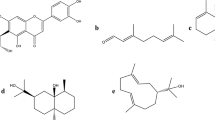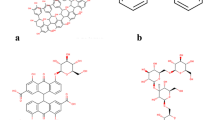Abstract
Background
Peroxisome proliferator-activated receptor gamma (PPAR-γ) is reported to regulate insulin sensitivity and progression of Type 2 diabetes mellitus (T2DM). Hence the present study is aimed to identify PPAR-γ regulators from Murraya odorata Blanco and predict their role to manage T2DM.
Methods
Multiple in-silico tools and databases like SwissTargetPrediction, ADVERPred, PubChem, and MolSoft, were used to retrieve the information related to bioactives, targets, druglikeness character, and probable side effects as applicable. Similarly, the Kyoto Encyclopedia of Genes and Genomes (KEGG) database was used to identify the regulated pathways. Further, the bioactives-protein-pathways network interaction was constructed using Cytoscape. Finally, molecular docking was performed using Autodock4.
Results
Twenty-five bioactives were shortlisted in which six were predicted as PPAR-γ modulators. Among them, stigmasterol was predicted to possess the best binding affinity towards PPAR-γ and possessed no side effects. Similarly, n-hexadecanoic acid was predicted to modulate the highest number of proteins, and protein CD14 was targeted by the highest number of bioactives. Further, the PI3K-Akt pathway was predicted as the maximum modulated genes.
Conclusions
The anti-diabetic property of the Murraya odorata Blanco of fruit pulp may be due to the presence of n-hexadecanoic acid and stigmasterol; may also involve in the regulation of the PI3K-Akt pathway which needs further investigated by in-vitro and in-vivo protocols.


Similar content being viewed by others
References
Baynes HW. Classification, pathophysiology, diagnosis and management of diabetes mellitus. J Diabetes Metab. 2015;6(5):1–9. https://doi.org/10.4172/2155-6156.1000541.
Lehmann JM, Moore LB, Smith-Oliver TA, Wilkison WO, Willson TM, Kliewer SA. An antidiabetic thiazolidinedione is a high affinity ligand for peroxisome proliferator-activated receptor γ (PPARγ). J Biol Chem. 1995;270(22):12953–6. https://doi.org/10.1074/jbc.270.22.12953.
Spiegelman BM. PPAR-gamma: adipogenic regulator and thiazolidinedione receptor. J Diabetes. 1998;47(4):507–14. https://doi.org/10.2337/diabetes.47.4.507.
Larsen TM, Toubro S, Astrup A. PPARgamma agonists in the treatment of type II diabetes: is increased fatness commensurate with long-term efficacy? Int J Obes (Lond). 2003;27(2):147–61. https://doi.org/10.1038/sj.ijo.802223.
Krentz AJ, Bailey CJ. Oral antidiabetic agents. Drugs. 2005;65(3):385–411. https://doi.org/10.2165/00003495-200565030-00005.
Bailey CJ, Day C. Traditional plant medicines as treatments for diabetes. Diabetes Care. 1989;12(8):553–64. https://doi.org/10.2337/diacare.12.8.553.
Khanal P, Patil BM. Gene ontology enrichment analysis of α-amylase inhibitors from Duranta repens in diabetes mellitus. J Diabetes Metab Disord. 2020. https://doi.org/10.1007/s40200-020-00554-9.
Jayakumar R. Herbal medicines for type-2 diabetes. Int J Diabetes Dev Ctries. 2010;30(3):111. https://doi.org/10.4103/0973-3930.66501.
Terstappen GC, Reggiani A. In silico research in drug discovery. Trends Pharmacol Sci. 2001;22(1):23–6. https://doi.org/10.1016/S0165-6147(00)01584-4.
Khanal P, Chikhale R, Dey YN, Pasha I, Chand S, Gurav N, Ayyanar M, Patil BM, Gurav S. Withanolides from Withania somnifera as an immunity booster and their therapeutic options against COVID-19. J Biomol Struct Dyn. 2021. https://doi.org/10.1080/07391102.2020.1869588.
Muthulakshmi AR, Margret RJ, Mohan VR. GC-MS analysis of bioactive components of Feronia elephantum Correa (Rutaceae). J Appl Pharm Sci. 2012;2(02):69–74.
Maity P, Hansda D, Bandyopadhyay U, Mishra DK. Biological activities of crude extracts and chemical constituents of Bael, Aegle marmelos (L.) Corr. Indian J Exp Biol. 2009;47:849–61.
Sabu MC, Kuttan R. Antidiabetic activity of Aegle marmelos and its relationship with its antioxidant properties. Indian J Physiol Pharmacol. 2004;48(1):81–8.
Mishra A, Garg GP. Antidiabetic activity of fruit pulp of Feronia elephantum Corr. Pharmacogn J. 2011;3(20):27–32. https://doi.org/10.5530/pj.2011.20.6.
Intekhab J, Aslam M. Constituents from Feronia limonia. An Univ Bucuresti Chimie. 2009;18(2):95–101.
Pandey S, Satpathy G, Gupta RK. Evaluation of nutritional, phytochemical, antioxidant and antibacterial activity of exotic fruit “Limonia acidissima”. J Pharmacogn Phytochem. 2014;3(2):81–8.
Kim S, Thiessen PA, Bolton EE, Chen J, Fu G, Gindulyte A, Han L, He J, He S, Shoemaker BA, Wang J. PubChem substance and compound databases. Nucleic Acids Res. 2016;44(D1):D1202-13. https://doi.org/10.1093/nar/gkv951.
Drug-Likeness and molecular property prediction. molsoft molecules in silico. Available at: https://molsoft.com/mprop/. Accessed 18 Nov 2020.
Ivanov SM, Lagunin AA, Rudik AV, Filimonov DA, Poroikov VV. ADVERPred–Web service for prediction of adverse effects of drugs. J Chem Inf Model. 2018;58(1):8–11. https://doi.org/10.1021/acs.jcim.7b00568.
Lagunin A, Ivanov S, Rudik A, Filimonov D, Poroikov V. DIGEP-Pred: web service for in silico prediction of drug-induced gene expression profiles based on structural formula. Bioinformatics. 2013;29(16):2062–3. https://doi.org/10.1093/bioinformatics/btt322.
Szklarczyk D, Gable AL, Lyon D, Junge A, Wyder S, Huerta-Cepas J, et al. STRING v11: protein-protein association networks with increased coverage, supporting functional discovery in genome-wide experimental datasets. Nucleic Acids Res. 2019;47(D1):D607–13.
Khanal P, Dey YN, Patil R, Chikhale R, Wanjari MM, Gurav SS, Patil BM, Srivastava B, Gaidhani SN. Combination of system biology to probe the anti-viral activity of andrographolide and its derivative against COVID-19. RSC Adv. 2021;11(9):5065–79. https://doi.org/10.1039/D0RA10529E.
Bindea G, Galon J, Mlecnik B. CluePedia Cytoscape plugin: pathway insights using integrated experimental and in silico data. Bioinformatics. 2013;29(5):661–3. https://doi.org/10.1093/bioinformatics/btt019.
Khanal P, Duyu T, Patil BM, Dey YN, Pasha I, Wanjari M, Gurav SS, Maity A. Network pharmacology of AYUSH recommended immune-boosting medicinal plants against COVID-19. J Ayurveda Integr Med. 2020. https://doi.org/10.1016/j.jaim.2020.11.004.
Halgren TA. Merck molecular force field. I. Basis, form, scope, parameterization, and performance of MMFF94. J Comput Chem. 1996;17(5-6):490–519. https://doi.org/10.1002/(SICI)1096-987X(199604)17:5/6<490::AID-JCC1>3.0.CO;2-P.
Biovia DS. Discovery studio visualizer. San Diego, CA, USA. 2017. pp. 936. Available link:https://discover.3ds.com/discovery-studio-visualizer-download.
Oo WM, Khine MM. Pharmacological properties of Feronia limonia fruit pulp–a review. Indo Am J Pharm Sci. 2017;7(04):8213–9.
Moreno E, Cordobilla R, Calvet T, Lahoz FJ, Balana AI. The C form of n-hexadecanoic acid. Acta Crystallogr Sect C Cryst Struct Commun. 2006;62(3):o129-31. https://doi.org/10.1107/S0108270106003106.
Bibo AM, Peterson IR. Phase diagrams of monolayers of the long chain fatty acids. Adv Mater. 1990;2(6-7):309–11. https://doi.org/10.1002/adma.19900020608.
Khanal P, Patil BM. Integration of network and experimental pharmacology to decipher the antidiabetic action of Duranta repens L. J Integr Med. 2020. https://doi.org/10.1016/j.joim.2020.10.003.
Walters WP, Murcko MA. Prediction of ‘drug-likeness’. Adv Drug Deliv Rev. 2002;54(3):255–71. https://doi.org/10.1016/S0169-409X(02)00003-0.
Huang X, Liu G, Guo J, Su Z. The PI3K/AKT pathway in obesity and type 2 diabetes. Int J Biol Sci. 2018;14(11):1483–96. https://doi.org/10.7150/ijbs.27173.
Xiao H, Gu Z, Wang G, Zhao T. The possible mechanisms underlying the impairment of HIF-1α pathway signaling in hyperglycemia and the beneficial effects of certain therapies. Int J Med Sci. 2013;10(10):1412–21. https://doi.org/10.7150/ijms.5630.
Kay AM, Simpson CL, Stewart JA Jr. The Role of AGE/RAGE Signaling in Diabetes-Mediated Vascular Calcification. J Diabetes Res. 2016;2016:6809703. doi:https://doi.org/10.1155/2016/6809703.
Author information
Authors and Affiliations
Contributions
Prarambh SR Dwivedi performed the work and drafted the manuscript. VP Rasal and Pukar Khanal had an equal contribution in designing the work, supervising, and final review of the manuscript. Ekta Kotharkar and Shailaja Nare assisted Prarambh SR Dwivedi in data mining and data analysis. All the authors of this manuscript approved the final manuscript.
Corresponding authors
Ethics declarations
Conflict of interest
Nil.
Ethical statement
Not applicable.
Additional information
Publisher’s note
Springer Nature remains neutral with regard to jurisdictional claims in published maps and institutional affiliations.
Rights and permissions
About this article
Cite this article
Dwivedi, P.S., Rasal, V.P., Kotharkar, E. et al. Gene set enrichment analysis of PPAR-γ regulators from Murraya odorata Blanco. J Diabetes Metab Disord 20, 369–375 (2021). https://doi.org/10.1007/s40200-021-00754-x
Received:
Accepted:
Published:
Issue Date:
DOI: https://doi.org/10.1007/s40200-021-00754-x




